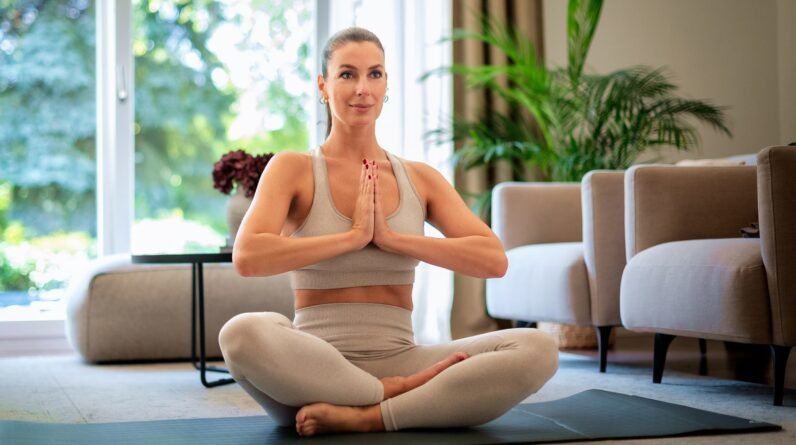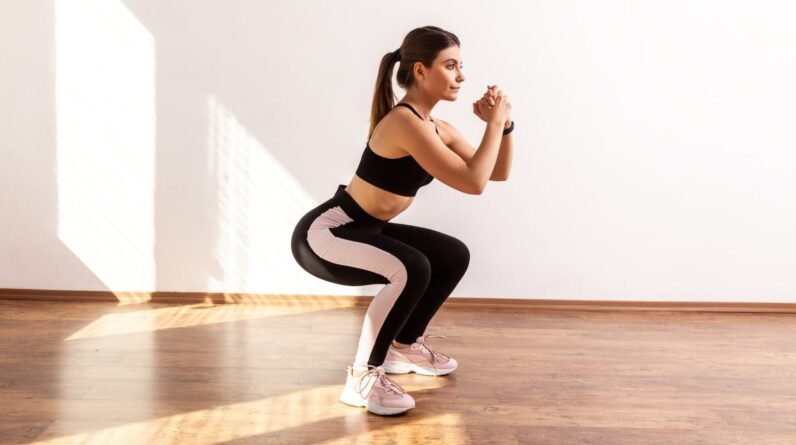
Like many people, I ended up in a fitness rut in 2020, and after missing my studios for months, I purchased a Peloton bike. Though I enjoyed having a piece of equipment in my home—and Peloton does offer a variety of classes beyond the bike itself—there was still something missing. I struggled to stick to my routine, and unfortunately, my shiny spin bike, once a beacon of hope, became a shrine of shame in the corner of my living room.
But last summer I got the chance to try a new piece of at-home workout equipment, the LIT Strength Machine, that promised to get me back on track when it come to working out. Part rower, part Pilates apparatus, part…something else entirely. By using water for resistance, a sliding carriage, and different resistance bands, the single machine is able to offer a host of exercise options.
Because this isn’t a connected device, there are no attached electronics—or cords—which has allowed me to enjoy outdoor workouts in the California sun, and I can use the arm attachment to hold my iPad for guided workouts, which come as part of your monthly subscription to LIT’s fitness app. To boot, it folds up, so as long as you have about two feet of space (wide) for the base of the machine, and at least seven-foot tall ceilings, you can keep it stored upright when it’s not in use.
At $1,800, it’s definitely still a pricey piece of equipment, but if you combine the costs of buying a hydro-powered rowing machine and a reformer, you’d be spending that much (most likely more) easily—and have to figure out where to store two pieces of equipment, which may or may not be a deal breaker depending on the size of your home. (LIT also offers financing, FYI.) Aside from the cost of the hardware itself, you’re looking at $25 a month (or $240 per year) for a subscription to the platform’s digital fitness library. With that being said, you don’t necessarily need the class subscription, though I do recommend it.
The workouts
So as you’ve probably already gathered, you’re not just doing rowing workouts on this machine—the app offers over 2,500 classes, ranging from 10-minute to one hour, with popular music, and a dozen instructors—though rowing makes up a significant category and is truly such a powerful (and underrated!) exercise category, in my humble opinion. Astronauts use rowing machines to train in space because they’re so damn effective, and use so many muscle groups simultaneously, including the legs, back, arms, and abdominals. During a rowing stroke, the muscles that are used the most are the back muscles, quadriceps, hamstrings, and glutes. The arms, shoulders, and abdominal muscles are also used to help generate power and control the rowing stroke.
Then you’ve got Pilates, which is, of course, another full-body workout—the LIT Method machine has components of a classic Pilates reformer, using the seat as a small carriage, with resistance bands added into different routines.
On top of that, there are injury recovery classes, core and conditioning workouts, stretching sessions, postnatal options, and even barre. If you don’t feel like doing a guided class, there are also “scenic rowing” videos where you can virtually row yourself through aquamarine seas or tropical lakes.
My experience using the LIT Strength Machine
One of my favorite parts about this machine is how low-maintenance, straightforward, and ass-kicking it is. Yet it starts out feeling like a “lazy’ workout“—I roll out in pajamas (not even athleisure) and no shoes, sit on the carriage, slide my bare feet under the foot straps, and start rowing. Whether I use one of the guided row workouts, or do my own combination, the result is always a full-body, sweat-soaked experience that hits every major muscle group in my body.
I love doing a simple 10-minute endurance row with Jazmin R on the app, or two different 10-minute sessions back to back. She teaches a lot of foundational skills that build proper form and strength to prepare you for other classes (both on and off the machine). The music is typically electronic, pop, and hip hop (think: anything from a Hardwell dance anthem to Snoop/Dr. Dre’s “The Next Episode” to something vibey by SZA). I dial into my rowing form and movement pattern; she’ll remind me about my grip and posture; and I’ll work through a series of smooth power strokes, as well as sprints. Jazmin’s energy is electric, so even the most basic beginner classes still feel strong and uplifting.
You can adjust the resistance with a dial on the water tank (which, IMO, is so cool… it’s all based on water!). This allows you to manage how challenging your workouts are, and make changes as needed.
Then there’s the Pilates classes—I missed the studio reformer workouts so much, and was craving a return to my favorite form of exercise. One memorable class I took was set to a Billie Eilish/Cardi B soundtrack (a winning combo) and used the seat and resistance bands with handles to replicate the long straps and carriage on a reformer.
I did a core series sitting on the seat, a strap handle in each hand, using a spinal twist motion from side to side and the strength of your arms to pull the carriage in and out. We also did an “elephant,” which is a signature reformer exercise, again using the seat as the carriage. We finished with some lateral lunges with one foot on the seat. These classes are dynamic, challenging, form-focused, and never boring or monotonous.
During the pandemic years, small (virtually insignificant) barriers to entry felt insurmountable—to me, at least! Something as simple as needing to put on cycling shoes and clip in was, for whatever reason, something that got in the way of working out more than once. With the LIT Strength Machine, I don’t even wear shoes half the time. I can just sit down and start rowing… no class, no shoes, no additional equipment necessary. I’ve literally done workouts in my pajamas, barefoot, multiple times.
All in all, the LIT Strength Machine offers some of the safest, most powerful, effective, and accessible forms of exercise that anyone can benefit from. The variety available keeps it interesting for your brain and body, and the instructors keep things positive and encouraging, while still helping you feel somewhat held accountable. The capacity to store it upright (or outside), and use your own up-to-date technology as a screen make this a home gym option that can evolve over time and work for a number of settings and lifestyles.







